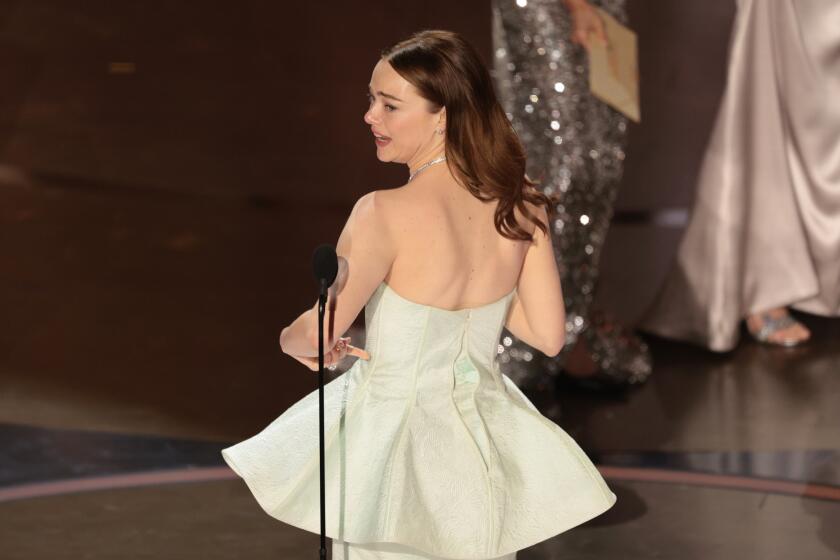Voter hearts and minds
‘THE rooting factor” is the most important thing to consider when predicting Oscar’s best picture nominees. It doesn’t matter if every academy member believes that “Babel” is the fifth-best film of 2006. Unless voters are actively rooting for it to win, it won’t be nominated.
That’s because the Oscars use a preferential ballot system, which favors the films ranked Nos. 1 or 2 when voters list their five choices for best picture nominees. Other award groups, like the guilds, use a weighted ballot that tallies points accorded to all suggested contenders, so their nominations often include films with widespread middling support.
Lucky for “Babel,” it’s among the movies with strong rooting constituencies. Others: “Dreamgirls,” “The Departed,” “The Queen,” “Little Miss Sunshine,” “Letters From Iwo Jima,” “United 93,” “The Pursuit of Happyness,” “Volver,” “Little Children,” even -- egad -- wacky “Borat,” taking into account all of those, ahem, eccentrics in the academy.
Oscar neophytes might pooh-pooh “Little Miss Sunshine” or “Pursuit of Happyness” because they don’t have hoity-toity appeal, but crowd-pleasers such as “The Full Monty” and “Seabiscuit” often sneak in because voters are, literally, cheering them on just like audiences do in theaters.
All a film really needs to be nominated is passionate support (those No. 1, and sometimes No. 2 votes) from one-sixth of the academy plus one voter. All other academy members could snub, say, foreign-language films like “Volver” or “Pan’s Labyrinth,” but they could still be nominated just as “Crouching Tiger, Hidden Dragon,” “Life Is Beautiful” and “Il Postino” proved in the past.
It helps if a movie has strong support across many academy branches. Nominees in other categories are chosen by peer group (writers on writers, film editors on film editors), but everybody votes on best picture. Thus, if a sound mixer votes for all of that boom-boom bang-bang in Clint Eastwood’s war flicks in the sound categories, he’s likely to put “Letters From Iwo Jima” or “Flags of Our Fathers” in the best-picture race while it’s on his mind.
Tom O’Neil writes the Gold Derby blog at TheEnvelope.com.
*
OTHER POINTERS TO KEEP IN MIND
Reality equals best picture. About half of the best picture nominees tend to be based on real people and events (12 of the last 25, for example). Biopics are especially popular, as “Ray” demonstrated by bursting into the best picture lineup two years ago. So keep an eye on “The Queen.”
“Ray” also benefited from an aggressive, last-minute campaign mounted by Universal, which could crank up similar ballyhoo for “United 93” now that it has been voted best picture by the New York Film Critics Circle. Late blitzkrieg campaigns sometimes work because they create a sudden bandwagon effect that inspires rooting. In their years, “Crash” and “The Cider House Rules” benefited from strong, late-breaking campaigns after being shut out at the Golden Globes.
Best picture equals best director. Three or four nominees in both categories tend to line up, so it’s wise to predict contenders for best picture based upon who directs them. Good choices are directors overdue for huzzahs (Martin Scorsese’s “The Departed”), breakout Brits (Stephen Frears’ “The Queen”), actors-turneddirectors and other academy darlings (Clint Eastwood’s “Iwo Jima” or Robert De Niro’s “The Good Shepherd”) and art-house faves (Alejandro Gonzalez Inarritu’s “Babel” or Pedro Almodovar’s “Volver”).
Best picture equals big picture. Voters are notorious suckers for movies with epic scope and ones with running times of more than two hours, raising hopes for “Letters From Iwo Jima” (141 minutes) and “Babel” (142 minutes).
-- Tom O’Neil
More to Read
Only good movies
Get the Indie Focus newsletter, Mark Olsen's weekly guide to the world of cinema.
You may occasionally receive promotional content from the Los Angeles Times.






